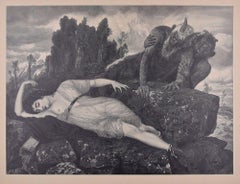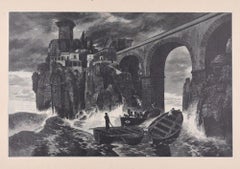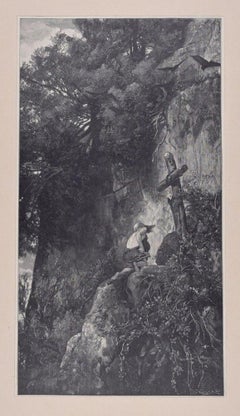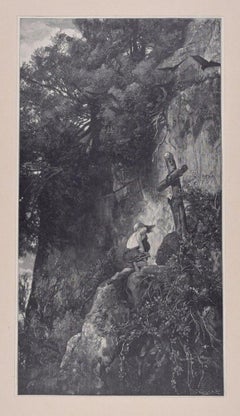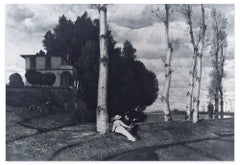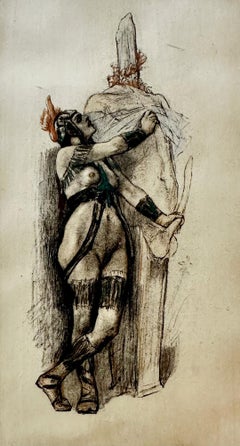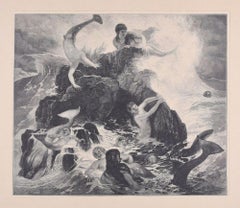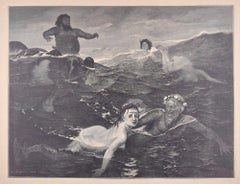Arnold Bocklin (After) Art
to
4
1
Overall Width
to
Overall Height
to
5
3
2
5
3
2
2
2
2
1
1
1
1
1
1
4
1
5
10,083
2,775
1,380
1,375
1
Artist: Arnold Bocklin (After)
Sleeping Diana - Original Woodcut by J.J. Weber - 1898
By Arnold Bocklin (After)
Located in Roma, IT
Image dimensions: 34.2 x 45.5 cm.
Sleeping Diana is an original print, realized in 1898.
Black and white woodcut print on applied Japon paper.
Good conditions except for yellowing of paper (especially along the margins), and very light folds on lower left side.
The print was realized by Johann Jacob Weber and it's part of the series Meisterwerke der Holzschneidekunst (original title: SECHZEHN HOLZSCHNITTE NACH GEMÄLDEN ARNOLD BÖCKLIN...
Category
1890s Symbolist Arnold Bocklin (After) Art
Materials
Woodcut
Pirates attack the Castle on the Sea - Original Woodcut by J.J. Weber - 1898
By Arnold Bocklin (After)
Located in Roma, IT
Image dimensions: 23 x 35 cm.
Original Title: Von Piraten überfallene Burg am Meer
Pirates attack the Castle on the sea is a black and white xylograph on Japon applied on ivory-colored paper, after Arnold Böcklin...
Category
1890s Symbolist Arnold Bocklin (After) Art
Materials
Woodcut
Der Büsser - Original Woodcut by J.J. Weber - 1898
By Arnold Bocklin (After)
Located in Roma, IT
Image dimensions: 34 x 19 cm.
Der Büsser is an original print, realized in 1898.
Black and white xylograph on applied Japon paper.
Good conditions except for yellowing of paper (especially along the margins), and little stains on lower margin.
The print was realized by Johann Jacob Weber and it's part of the series Meisterwerke der Holzschneidekunst (original title: SECHZEHN HOLZSCHNITTE NACH GEMÄLDEN ARNOLD BÖCKLIN...
Category
1890s Symbolist Arnold Bocklin (After) Art
Materials
Woodcut
Centaur In The Smithy - Original Woodcut by J.J. Weber - 1898
By Arnold Bocklin (After)
Located in Roma, IT
Image dimensions: 24.5 x 31.5 cm.
Centaur In The Smithy is an original print, realized in 1898.
Black and white xylograph on applied Japon paper.
Good conditions except for yellowing of paper (especially along the margins), and very light foxings on lower part of paper.
The print was realized by Johann Jacob Weber and it's part of the series Meisterwerke der Holzschneidekunst (original title: SECHZEHN HOLZSCHNITTE NACH GEMÄLDEN ARNOLD BÖCKLIN...
Category
1890s Symbolist Arnold Bocklin (After) Art
Materials
Woodcut
Fruhling - Original Woodcut After Arnold Bocklin - 1890s
By Arnold Bocklin (After)
Located in Roma, IT
Frühling is a wonderful black and white photogravure of the original painting by Arnold Böcklin (Basel 1827 - Fiesole 1901), probably edited by Bruckman...
Category
1890s Symbolist Arnold Bocklin (After) Art
Materials
Lithograph
Related Items
Divine Comedy : Dante and Beatrice - Original lithograph, 1898
By Henri Martin
Located in Paris, IDF
Henri MARTIN
Divine Comedy : Dante and Beatrice, 1898
Original lithograph (Champenois workshop)
Printed signature in the plate
On vellum, 40 x 31 cm (c. 16 x 12 in)
INFORMATION: Li...
Category
1890s Symbolist Arnold Bocklin (After) Art
Materials
Lithograph
$300
H 15.75 in W 12.21 in
Prêtresse antique (Ancient Priestess)
By Félicien Rops
Located in Middletown, NY
Heliogravure by Félicien Rops (1833 – 1898), a Belgian artist, known primarily as a printmaker in etching and aquatint. He is noted for his drawings depicting erotic and Satanic them...
Category
Late 19th Century Symbolist Arnold Bocklin (After) Art
Materials
Handmade Paper, Photogravure, Stencil
Night Dream : the Swanns - Original Lithograph, 1898
Located in Paris, IDF
Francis JOURDAIN
Night Dream : the Swanns, 1898
Original lithograph (Champenois workshop)
Printed signature in the plate
On vellum, 40 x 31 cm (c. 16 x 12 in)
INFORMATION: Lithogra...
Category
1890s Symbolist Arnold Bocklin (After) Art
Materials
Lithograph
Die Nacht (The Night), nude and cupids, German antique engraving
By Virgilio Tojetti
Located in Melbourne, Victoria
'Die Nacht'
(The Night)
German wood-engraving, 1903.
310mm by 230mm (image)
410mm by 280mm (sheet)
Category
Early 20th Century Symbolist Arnold Bocklin (After) Art
Materials
Engraving
1001 Nights - SURREALIST WOMAN DEAD IN A TREASURE BOX
Located in Santa Monica, CA
RICHARD TESCHNER (Prague 1879 – 1948)
From: A Thousand and One Nights -
SURREALIST WOMAN DEAD IN A TREASURE BOX, 1917 Aquatint, Proof no. 17. Aqua...
Category
1910s Symbolist Arnold Bocklin (After) Art
Materials
Aquatint
Mother Earth
By William Strang, R.A., R.E.
Located in New York, NY
William Strang (1859-1921), Mother Earth, 1897, etching, drypoint, aquatint ); signed in pencil lower right, and signed by the printer David Strang and...
Category
1890s Symbolist Arnold Bocklin (After) Art
Materials
Drypoint, Etching, Aquatint
Die Nixen (Mermaids), nudes, German antique engraving
By Virgilio Tojetti
Located in Melbourne, Victoria
'Die Nixen'
(Mermaids)
German wood-engraving, 1903.
230mm by 320mm (image)
280mm by 410mm (sheet)
Category
Early 20th Century Symbolist Arnold Bocklin (After) Art
Materials
Engraving
Kraft und Mut (Courage and Strength), German antique engraving
Located in Melbourne, Victoria
'Kraft und Mut'
(Courage and Strength)
German wood-engraving, 1903.
320mm by 230mm (image)
280mm by 410mm (sheet)
Category
Early 20th Century Symbolist Arnold Bocklin (After) Art
Materials
Engraving
Ghosts of New York 2, monochromatic dramatic city-scape surrealistic undertones
By Tom Bennett
Located in Brooklyn, NY
One of a series of oil-based monotypes on fine printmaking paper. Monochromatic with subtle color. Moody, symbolist/expressionist image reflecting on NY city's ambient current and past.
Category
2010s Symbolist Arnold Bocklin (After) Art
Materials
Monotype, Archival Paper
$350
H 12 in W 12 in D 0.2 in
"Dying Woman" Copper Plate Heliogravure
By Ferdinand Hodler & R. Piper & Co.
Located in Palm Beach, FL
2018 marks the centenary anniversary of Ferdinand Hodler’s death. In that 100 years time, the art world’s esteem of this important artist has proved fickle. It has shifted from extol...
Category
1910s Symbolist Arnold Bocklin (After) Art
Materials
Paper
$1,500
H 17.75 in W 27.63 in
Bridges. From the series “My Riga”. 1967. Paper, linocut, 69x103 cm.
Located in Riga, LV
Bridges. From the series “My Riga”. 1967.
Paper, linocut, 69x103 cm.
Category
1960s Symbolist Arnold Bocklin (After) Art
Materials
Paper, Linocut
$1,681
H 27.17 in W 40.56 in D 0.04 in
Session VI, paper/etching, 63/75, 11x12 cm, 1988
Located in Riga, LV
Session VI, paper/etching, 63/75, 11x12 cm, 1988
Category
1980s Symbolist Arnold Bocklin (After) Art
Materials
Paper, Etching
$576 Sale Price
20% Off
H 4.34 in W 4.73 in D 0.04 in
Previously Available Items
The Neiads - Original Woodcut by J.J. Weber - 1898
By Arnold Bocklin (After)
Located in Roma, IT
Image dimensions: 24 x 27.8 cm
Original title: Die Najaden
The Neiads is a black and white xylograph on Japon applied on ivory-colored paper, after Arnold Böcklin, realized by the German artist Johann Jacob Weber (Basel 1803, Leipzig 1880).
A really superb plate with lifetime impression, from the collection "Sechzehn Holzscnitte nach Gemälden Arnold Böcklin (Meisterwerke der Holzschneidekunst, Neue Folge Heft V), leipzig, verlagsbuchhandlung von J.J. Weber", printed in 1898 by J.J. Weber.
All the plates of this print suite are woodcuts on the head wood and taken from Böcklin's most famous paintings.
Johann Jacob Weber was the talented executor and creator of the Meisterwerke der Holzschneidekunst series which also includes a famous folder of his woodcuts taken from the artworks by Sascha Schneider...
Category
1890s Symbolist Arnold Bocklin (After) Art
Materials
Woodcut
H 17.01 in W 20.99 in D 0.08 in
In the Game of Waves - Original Woodcut by J.J. Weber - 1898
By Arnold Bocklin (After)
Located in Roma, IT
Image dimensions: 35.4 x 45.7 cm
Original title: Im Spiel der Wellen
In the Game of the Waves is a black and white xylograph on Japon applied on ivory-colored paper, after Arnold Böcklin, realized by the German artist Johann Jacob Weber (Basel 1803, Leipzig 1880).
A superb plate with lifetime impression, from the collection "Sechzehn Holzscnitte nach Gemälden Arnold Böcklin (Meisterwerke der Holzschneidekunst, Neue Folge Heft V), leipzig, verlagsbuchhandlung von J. J. Weber", printed in 1898 by J.J. Weber.
All the plates of this print suite are woodcuts on the head wood and taken from Böcklin's most famous paintings. Johann Jacob Weber was the talented executor and creator of the Meisterwerke der Holzschneidekunst series which also includes a famous folder of his woodcuts taken from the artworks by Sascha...
Category
1890s Symbolist Arnold Bocklin (After) Art
Materials
Woodcut
H 17.09 in W 21.03 in D 0.08 in
Triton and Nereid - Original Woodcut by J.J. Weber - 1898
By Arnold Bocklin (After)
Located in Roma, IT
Image dimensions: 35.7 x 42.6 cm.
Triton and Nereid is an original print, realized in 1898.
Black and white xylograph on applied Japon paper.
Good conditions except for yellowing ...
Category
1890s Symbolist Arnold Bocklin (After) Art
Materials
Woodcut
H 17.13 in W 20.99 in D 0.08 in
Silence in the Woods - Original Woodcut After J.J. Weber - 1898
By Arnold Bocklin (After)
Located in Roma, IT
Image dimensions: 30.5 x 24.4 cm.
Original Title: Schweigen im Walde
Silence in the woods is a superb xylograph on Japon applied on ivory-colored paper, after Arnold Böcklin, by Johann Jacob Weber.
A wonderfuòl black and white plate from the print suite "Sechzehn Holzscnitte nach Gemälden Arnold Böcklin (Meisterwerke der Holzschneidekunst, Neue Folge Heft V), leipzig, verlagsbuchhandlung von J.J. Weber", printed in 1898 by J.J. Weber.
Our copy as all the plates of the print suite, is a woodcut painted on the head wood and taken from Böcklin's most famous paintings. J.J. Weber was the executor and creator of the Meisterwerke der Holzschneidekunst series which also includes a famous folder of his woodcuts taken from the works of Sascha Schneider...
Category
1890s Symbolist Arnold Bocklin (After) Art
Materials
Woodcut
H 21.19 in W 17.13 in D 0.08 in
Poetry and Painting Muses - Original Woodcut by J.J. Weber - 1898
By Arnold Bocklin (After)
Located in Roma, IT
Image dimensions: 29.7 x 24.5 cm.
Poetry and Painting Muses is an original print, realized in 1898.
Black and white xylograph on applied Japon paper.
Good conditions except for yellowing of paper (especially along the margins), and a stain on higher right side.
The print was realized by Johann Jacob Weber and it's part of the series Meisterwerke der Holzschneidekunst (original title: SECHZEHN HOLZSCHNITTE NACH GEMÄLDEN ARNOLD BÖCKLIN...
Category
1890s Symbolist Arnold Bocklin (After) Art
Materials
Woodcut
H 21.07 in W 17.13 in D 0.08 in
Arnold Bocklin (after) art for sale on 1stDibs.
Find a wide variety of authentic Arnold Bocklin (After) art available for sale on 1stDibs. You can also browse by medium to find art by Arnold Bocklin (After) in woodcut print, lithograph and more. Not every interior allows for large Arnold Bocklin (After) art, so small editions measuring 18 inches across are available. Arnold Bocklin (After) art prices can differ depending upon medium, time period and other attributes. On 1stDibs, the price for these items starts at $292 and tops out at $501, while the average work can sell for $334.
Artists Similar to Arnold Bocklin (After)
Questions About Arnold Bocklin (After) Art
- What was Eve Arnold famous for?1 Answer1stDibs ExpertJanuary 19, 2025Eve Arnold was famous for her work as a photojournalist. Arnold photographed many of the iconic figures who shaped the second half of the 20th century. Yet, she was equally comfortable documenting the lives of the poor and dispossessed. Her joyful picture of a Cuban couple with their child was selected in 1955 for the world-touring Museum of Modern Art exhibition The Family of Man and seen by nine million visitors. Arnold’s images of Marilyn Monroe on the set of The Misfits (1961) were perhaps her most memorable, but she had taken many photographs of the actress from 1951 onward. Her previously unseen images of Monroe were shown at a Halcyon Gallery exhibition in London in May of 2005. She also photographed Queen Elizabeth II, Malcolm X, Marlene Dietrich, and Joan Crawford and traveled around the world, photographing in China, Russia, South Africa and Afghanistan. Find a collection of Eve Arnold photography on 1stDibs.
- 1stDibs ExpertOctober 15, 2024Designer Arnold Scaasi's real last name was Isaacs. He changed his name when he moved from Canada to the U.S. in the 1950s. In 1956, he introduced his eponymous clothing line and staged his first ready-to-wear fashion show. Within two years, he won the Coty American Fashion Critics’ Award. Scaasi designed dresses for numerous films and multiple U.S. First Ladies, including Mamie Eisenhower, Barbara Bush, Hillary Clinton and Laura Bush. Shop a selection of Arnold Scaasi apparel on 1stDibs.
